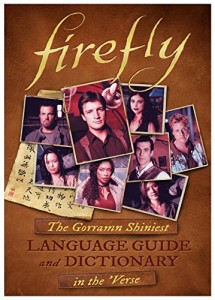All this week, I’m celebrating the release of Firefly: The Gorramn Shiniest Dictionary and Phrasebook in the ‘Verse from Titan Books. Each day, I’m going to post about an aspect of working as a media/tie-in writer. I hope you enjoy this series of posts! Interested in the dictionary, but are still on the fence? Be sure to read Take Five with Monica Valentinelli on Suvudu.com for some interesting tidbits about the book and my process. If you’re keen on learning more about me, then check out my interview with GeekDad, too!
For today’s blog post, I’m going to talk about an aspect of media/tie-in that tends to generate love/hate discussions more so than answering the question about whether or not ketchup belongs on macaroni-and-cheese. Phew! I should probably avoid the topic entirely, as conversations tend to be rather heated about the subject, but I’m going to do my best not to be inflammatory as that is not the point of this post.
Fans, Consumers, Customers, and Fandom
To be a fan, in my mind, is to simply like or love something to varying degrees. That’s it. I don’t believe there is such a thing as the “one true fan” for many reasons, but much of it for me comes down to the difference between fan and customer. A fan has an emotional response to a character, story, etc. You can be a fan, then, of Zatanna or Star Wars or The Snorks. A customer, on the other hand, is the person who values a title by spending money or time to acquire a title (buying, renting, borrowing, checking out from a library). You don’t always have to own something in order to like it, however, and this tends to hold true if there’s a lot of product. A reader (or viewer/player/etc.), then, is the person who consumes that “something”.
Note: I didn’t use the term consumer here, because it’s often conflated with customer. Here, I specifically mean the cycle of going to a comic book store and buying a comic (customer), reading it (reader), and then loving a character (fan). Rinse. Repeat.
Though there is a lot of overlap, these three types aren’t always the same person, nor do they always and consistently relate to one another in the same way. The longer the character/story has been around, the more likely there are going to be differences between them. You can buy a comic without being a fan for someone else–especially if it’s for your kid. You can be a fan of Adam Wests’ Batman, but aren’t a fan of Michael Keaton’s. You can love the so-called golden age of comics, but you spend your time reading contemporary comics even though you don’t like them as much. For older properties, time and the amount of materials produced are both huge factors.
Fandom, then, I view to be a bunch of people with shared interests. Sometimes, they form communities and actively share their thoughts or show their feelings for characters/stories with each other. Sometimes they buy All The ThingsTM; sometimes they make other things based on their likes and loves. Sometimes, they express themselves in a public form. Sometimes, however, they don’t. Being a member of a community, to me, isn’t a requirement to be a fan, but my point here is that “fandom” is not a monolithic, contained, and identifiable group of people simply because there are many groups and, while some are organized, not all of them are. They’re not always “visible”, either, for a variety of reasons.
Part of the reason why it’s such a shock that women, for example, play video games and buy comics and read/write fantasy novels isn’t because women haven’t always been interested in these things. Nor, have female characters always been approached the same way, either. Ripley. Sarah Connor. Wilma Deering–even Mrs. Peltzer from Gremlins. The internet has simply made female fans more visible, because it’s given us an access point to be able to buy the things we want without any grief or harassment. The same holds true for underrepresented or marginalized people as well; they didn’t just “show up”. Remember: people tend to go where they feel welcome especially if they no longer feel isolated. Connecting through fandom, through that shared interest or love for a hero/heroine, is a strong common interest. Thus, either the larger (known) groups or professionally organized events, companies, etc. will actively and consciously work towards inclusion, or the people who aren’t being treated well will either abandon fandom entirely or make their own space. After all, what is fandom but a collection of many different kinds of people?
Again, I feel this [fans] all goes back to a single (or series) of moments caused by a powerful emotional connection with a character or a story. And, all fans–regardless of who they are or where they’re from–wish to see themselves represented carefully and appropriately in their fandoms. Storytellers, like myself, are keen on seeking ways to create new fans and satisfy existing fans by doing just that.
Canon vs. Continuity
Many of the discussions become heated with respect to canon. In a fan’s mind, I propose that typically the version of the character/story that they fell in love with is the official version. Or, alternatively, whatever they viewed last. The canon originates not from the entire body of work, but from that portion of the work the fan read, played, or viewed. For them, that canon sets their expectations for the next thing they’ll consume in that universe. These assumptions will vary widely, of course, but I do see them tied to a number of factors: age of property, which iteration of a character/story they first encountered, gaps between publishing cycles, amount of material to consume, etc. In some cases, this becomes more challenging to navigate because Wonder Woman, for example, has been around since 1941. There are many people alive today who have lived through all iterations of her character–so who’s to say which version is “the” authoritative or most popular one with respect to the fans?
Now, the thing about canon, is that in my experiences it tends to be tied to an individual’s emotions and memories. Sometimes, but not always, this means that a fan might misremember the details of the original story–which is human nature and completely understandable. But, emotions aren’t based on facts, they’re feelings that are generated from some “thing” that touched that person, rather than the entirety of a body of work–or even a single film. I had this experience when I was working on Firefly, because some folks believed that Reavers were a huge part of the TV show. They weren’t; they didn’t even show up in the final episode as the crew was navigating deeper into the Blue Sun System. After several conversations I discovered that what they remembered, however, were Reavers from the Serenity movie. But, to them, that’s canon and that is what set their expectations.
Continuity and canon go hand-in-hand, and sometimes the two words are used interchangeably. Canon, however, is something that’s established by producing a body of work, which then becomes the canon. In a business-y sense, sometimes canon is also used as a means of reflecting the official details of an IP (setting/characters/events/logos/etc.) that first appeared in that work. Continuity, however, is focused on which of those elements will remain the same and, most importantly, what can be changed to tell a story using the same characters. Sure, continuity is about drawing an unbroken line through a series of comics or what-have-you but, from a creative perspective, I also see how continuity shapes the boundaries of a character’s identity as opposed to a pile of characteristics that form a costume.
Please also note: I’m not going to do another deep dive into licensing, but I did have a thought I wanted to add about movie remakes in particular. Whenever a remake is announced, I keep hearing how Hollywood doesn’t have any new ideas–or a fan’s childhood is destroyed because the character they love is being remade. This is a visceral, emotional reaction to an existing feeling, because that change is internalized as a threat. Of course, remakes occur due to the mechanisms in place for a license. My point here is that fans don’t care about the business-y details, and that is something I have to consider when weighing feedback and criticism. The only thing companies can measure is how much is spent on a particular project; if fans expect to hate a movie, but they see it anyway and their fears are fulfilled? All the data the company has to go on is how much money that movie made. Occasionally, the dollars earned send the wrong message, especially if the work wasn’t up to par or if there are entrenched ideas about… Female superhero movies. Ahem. Just as an example.
Okay, end segue…
Factoring in Creators
For the purposes of talking about creators, I need to table fandom for a bit. I’m going to relate how canon (e.g. the full body of work) and continuity (e.g. the continuous details of characters/events/settings in a single work or series of them) affect what I do.
Whenever I start a media/tie-in project, I ask a lot of questions because I need to know how much creative freedom I have. Some publishers are very clear on what they want/need/expect, while others are trying to figure that out based on the plots or storylines writers propose. I can channel my own fandoms into what I’m proposing but, at the end of the day, I am here to reach as many readers as possible. Please note: I did say “readers” as opposed to “fans.” I love fans, I really do. But, a fan who is not invested in the story I’m telling won’t have an emotional reaction based on the material I’ve produced. A reader, on the other hand, will. So, I tend to focus on readers (who are hopefully also fans) by figuring out who this comic is for. For larger IPs, figuring out where my constraints are helps me get a clearer sense of what materials fans might already be familiar with. If the answer from my editor is “I don’t know. I’m more concerned about publishing a good story!” then I focus more strongly on something else: the core of a character’s identity and how the story impacts them. Who a character is, deep down, is crucial to offering an appealing story for fans–because this is key to expectations. Change the core identity of a character, and almost certainly a fan will become upset.
Tying that back into fans, themselves… In my experiences, fans have expectations based on both the stories and the characters they love. But, many fans also want to see themselves in a story, too, so they’re more open to casting changes like Oded Fehr as Doctor Strange or, in a “real world” scenario, Daisy Ridley as the protagonist in The Force Awakens. For other fans, however, changing canon threatens their familiarity with a character/story and challenges their feelings in a way that makes them uncomfortable. Again, the longer a property has been around, the more likely this is to happen, but it’s also tied to other factors related to entrenched (stupid) stereotypes. Nobody, and I mean nobody, should have to prove they like a thing or that they exist or that they deserve to be treated with dignity.
As a creator, I feel it’s definitely a challenge to strike the balance between satisfying fans and the publisher—especially since it’s impossible to make everybody happy. But, I also feel that the longer a property has been around, the more opportunities we have to experiment and tell new stories, too. This, to me, isn’t intimidating or scary or frightening. Telling new stories is very exciting! It’s a hard thing, trying to balance the expectations of everybody involved, and that’s partly why I love working in media/tie-in. Make no mistake, however: without readers willing to invest in my stories, without customers willing to buy them, without fans falling in love with characters all over again–I would not be able to do what I do.




Comments are closed.